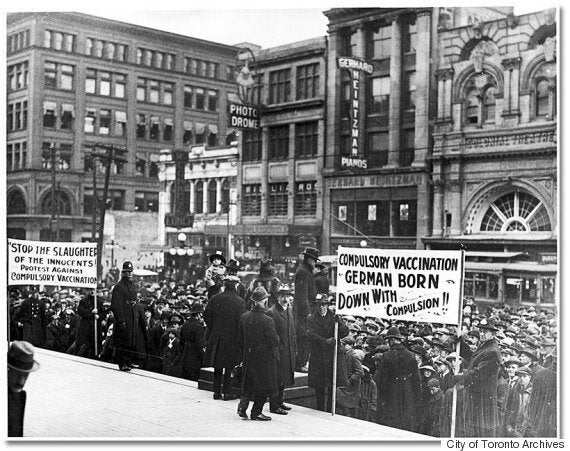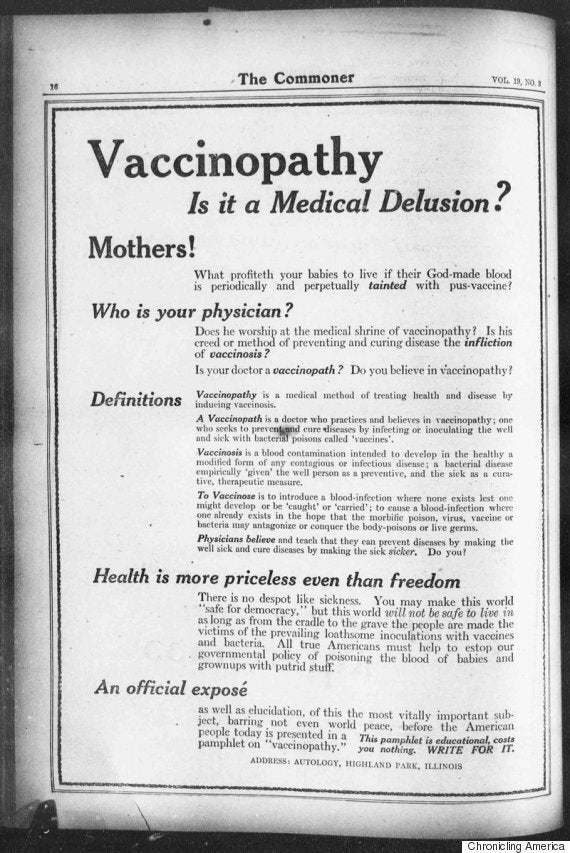As any modern parent knows, once-routine childhood vaccinations have become a hot-button topic as the anti-vax movement continues surging.
Many peg this opposition to the fake news precursor that was now-disgraced doctor Andrew Wakefield's discredited 1998 study linking vaccinations with autism.
Of course, nearly 20 years later, we live in a world where peer-reviewed science and award-winning journalists are regularly ignored in favour of sketchy websites making specious claims. Wakefield, after losing his medical license, has even returned to the fight with a controversial 2016 documentary "Vaxxed: From Cover-Up to Catastrophe" that continues to spread his disproved autism conspiracy theories.
Americans have even elected anti-vaxxer to the White House — Trump has been tweeting out alleged connections between vaccines and autism for years years.
A NY Times op-ed even declared in February that "it’s looking as if 2017 could become the year when the anti-vaccination movement gains ascendancy in the United States."
Canada, however, is no better. Though press coverage rises and falls with outbreaks, vaccination rates have been falling here and, unsurprisingly, as Global News reported, the rate of vaccine-preventable infections have jumped 30 per cent in Canada since 2005.
Vaccine-preventable infections have jumped 30 per cent in Canada since 2005.
World Immunization Week, which takes place the last week of April, only dates to 2012 and is part of a concerted World Health Organization effort to push back against the growing anti-vax movement by touting the safety of the science and the two to three million deaths prevented annually by vaccines.
But the main arguments being made against vaccines on social media, message boards, blogs and fringe media publications are pretty much the same ones that have been made for over a century.

The photo above is of a protest by the Anti-Vaccination League of Canada outside of Old City Hall on November 13, 1919.
Hundreds of anti-vaxxers rallied against the "slaughter of the innocents," which was actually a short-lived compulsory smallpox vaccination campaign for children to stop an outbreak that grew to 2,864 infections.
Less than 60 years earlier, an 1862 epidemic killed 30,000 people, mostly First Nations, in British Columbia. An outbreak in Montreal in 1885 killed another 3,000 people, sparking mandatory vaccinations and, in turn, violent anti-vax riots leading to street-fighting, attacks on police stations, torching of doctors' houses and, eventually, the army being called in to restore order.
Hundreds of anti-vaxxers rallied against the "slaughter of the innocents," which was actually a short-lived compulsory smallpox vaccination of children campaign to stop an outbreak.
(Even bigger riots had broken out in in London, England that same year, attracting more than 20,000 anti-vaxxers from a movement that began in 1867 when the compulsory smallpox vaccination law was broadened.)
The Montreal epidemic led to Ontario's 1887 Vaccination Act that "stipulated that parents must have their children vaccinated against smallpox within three months of birth and re-vaccinated when necessary every seven years." It also allowed compulsory vaccination orders in the event of outbreaks and allowed school boards to require vaccination certificates.
This, in turn, led to forming of the aforementioned Anti-Vaccination League of Canada in 1900, which returned in force in 1919 along with the return of smallpox.
The Anti-Vaccination League leaders argued that "vaccination is simply the old scientific absurdity of using disease to fight disease" and spread lies claiming the vaccine was "made from the grease taken from the heels of horses, from swine pox, and even from dead bodies," reported Blog TO, adding that they were made in a lab from "specially kept cows."
They argued that it was an infringement on their freedom, even changing their name to the Anti-Vaccination and Medical Liberty League of Canada, and claimed that "public health officials used vaccination as a "ploy to avoid [more expensive] sanitary measures.'"
These groups also appealed to fear and guilt, like with this 1919 Nebraska newspaper ad that Vox turned up: "Mothers! What profiteth your babies to live if their God-made blood is periodically and perpetually tainted with pus-vaccine?"

So the early 20th century anti-vax argument was about freedom, government conspiracies, pseudoscience, parental anxiety and "the arbitrary pollution of children's bodies in Toronto with animal matter," while a century later it's about freedom, Big Pharma conspiracies, pseudoscience, parental anxiety and the use of minimal amounts of mercury and aluminium as adjuvants.
Dr. Charles Sheard, Toronto's Medical Officer of Health at the time of the 1919 protests, called the "anti-vacs," "a hygienic cult, holding opinions on medical and health matters opposed to the well-grounded convictions of the physicians of the whole world" and dismissed them as "ignorant and superstitious," according to an academic article by Katherine Arnup on "opposition to compulsory immunization in Ontario."
So, to be fair, the anti-anti-vax opinion hasn't changed much either.
But what has changed is this: there's no more smallpox.
As recently as 1967, two million people died of smallpox. But it was declared eradicated in 1980 following a global immunization campaign.
The disease that sparked the 1919 anti-vax protests killed over 300 millionin the century alone, or three times the number of war-related deaths. In the 19th century, smallpox killed 400 million, including most of the indigenous population of the Americas after being brought over by infected Europeans.
As recently as 1967, two million people died of smallpox. But it was declared eradicated in 1980 following a global immunization campaign.
Polio is almost there, too, with infections decreasing by 99 per cent since 1988. Then there's measles, which is what comes up most in modern anti-vax arguments which focus on the MMR (measles, mumps and rubella) shot and which pops up semi-regularly, most recently in Halifax earlier this year while Toronto simultaneously experienced a mumps outbreak.
Measles used to kill 2.6 million children a year prior to the vaccine being introduced in 1980, but in 2015 it "only" killed 134,200, which is still 15 kids dying every hour.
The other big change over the past hundred years is that our scientific understanding has grown greater and our methods have gotten safer.
Though skeptics may not remember what it was like to live in a world where vaccine-preventable diseases killed children in Canada and around the world, they surely wouldn't want to return to those dark ages.